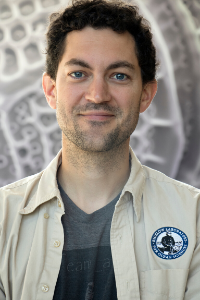
Meet Maine-eDNA: Nick Record, Senior Research Scientist, Bigelow

Nick Record has worked on projects covering topics from viruses to whales and ocean physics, but he always comes in with the math and computer science piece of the puzzle. Record is a senior research scientist at Bigelow Laboratory for Ocean Sciences, where he’s worked for seven years. Record is also a researcher on Maine EPSCoR’s current NSF EPSCoR Track-1 grant, Maine Environmental DNA (Maine-eDNA).
While many of the research projects within Maine-eDNA are focused on one specific question, Record finds that the computer science and math aspects help serve as important tools for linking ecosystems together to help understand how the ocean works as a whole system.
“What I really like about the math and computer science perspective is that so many problems in ocean science are interdisciplinary,” Record said. “Computational thinking is a way of crossing and blending all the different disciplines in a way that I think you need to answer these fundamentally interdisciplinary problems.”
Record’s work with Maine-eDNA is focused on using eDNA as a tool to help forecast ecosystems. Ecosystem forecasting is similar to weather forecasting, but aims to predict other aspects of the environment. One way Record hopes to use data and computational models is to forecast HABs (harmful algal blooms). HABs are algae that produce harmful toxins that end up accumulating in shellfish. HABs are usually monitored so that people don’t ingest those toxins, but businesses usually have to resort to shutting down their aquaculture or harvesting operations.
“A lot of people have been asking for an early warning system or some advanced notice of when they’re going to have to shut down and when they’re going to be able to reopen,” Record explained. “By monitoring eDNA, we can get early indications of whether those toxic species are on the rise.”
While COVID-19 shut down much of Maine-eDNA’s field work earlier in the summer, Record and his team have been able to continue their work remotely, since most of Record’s research is computational.
“I found, actually, with more people stuck at home, there’s a lot more interest in learning and developing these coding tools,” Record said.
As COVID-19 restrictions lift, allowing researchers to collect more data in the field, Record hopes to spend time organizing data and writing coding tools to create computational models with the eDNA data.
One of Record’s projects that has come together over the past few months is a data portal that shows eDNA data that has been collected in the state of Maine. This data portal, which can be found at eDNA.bigelow.org, can be used for forecasting among other things. Record and his team have also started building a tool that would pull together all existing data for any location. Record hopes tools like these will help researchers, who might have highly focused projects, understand what else is going on in the environment, or what other data they may be able to bring in to think about broader connections in the ecosystem.
To expand these databases, Record is excited to use eDNA with community science. Individuals within the community would collect eDNA data on their own, using smartphone-enabled devices that conduct qPCR (or quantitative polymerase chain reaction), and researchers like Record would find a way to combine the data. This would eventually create a strong community of scientists who are knowledgeable about eDNA and are both bringing in their own data and related insights.
Not only can eDNA tools be used to forecast things like HABs, but they could potentially be used to forecast outbreaks of COVID-19. Fellow Maine-eDNA researcher, Pete Countway (Senior Research Scientist at Bigelow Laboratory for Ocean Sciences) is exploring options for environmental and wastewater testing to help track the virus. Detecting the disease in the environment could help researchers predict what might become a COVID-19 outbreak, before infected people begin showing symptoms.
“I see this project as a steppingstone to eDNA becoming a really widespread, accessible technology that gives us a lens to our environment that we haven’t had before,” Record said. “And hopefully that lens would be available to everyday people as well as scientists.”
